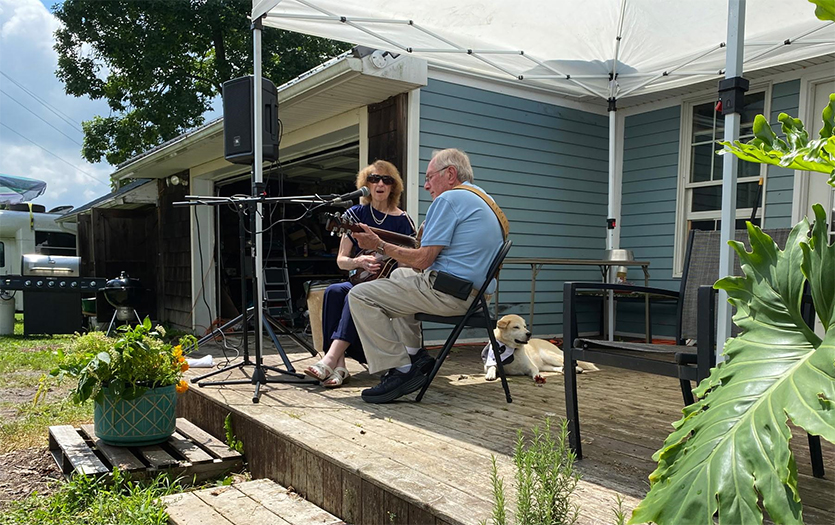
This post was written by Judy Tillapaugh, RDN, LD, CPT, dietitian, Parkview Behavioral Health Institute Eating Disorder Program.
It’s Monday. Consider two friends who are up and ready to start the day together with fitness. Each is hydrated, wearing comfortable clothes and supportive shoes. There’s a plan for what they will do, where they will go, and for how long. And yet, their intentions are different. One has to expend a certain amount of calories and will feel guilty if the heart rate is not in a certain heart rate zone. The other wants to move to feel good and have a meaningful conversation. One has a rigid focus while the other doesn’t.
The question is, which approach will support a lasting fitness routine?
The good and the bad
Regular movement offers hundreds of physical, mental and social benefits, and there’s no doubt investing in a fitness regimen as part of self-care can increase our quality of life and well-being.
Unfortunately, studies indicate that about 50% of people who start a workout program will quit within six months. Even more concerning, 1 in 4 adults don’t meet physical activity recommendations. Most Americans simply aren’t committing to lifelong movement. We see a lot of the “I’ll start on Monday” mentality, but healthy habits just don’t seem to be sticking.
A complex relationship with exercise
There are countless reasons why a person might abandon their fitness routine, and some aren’t as straightforward as others. Because of the work that I do, I know that certain populations have complicated implications tethered to moving their bodies. For example, research says there is a strong link between compulsive exercise and eating disorders. In these instances, fitness takes on an entirely different, very rigid role.
Others may have had a traumatic experience in the past and see quitting as an act of rebellion against a parent, coach or peer who pushed exercise and made the individual feel like a failure if they didn’t reach a certain expectation.
On top of these deeper reasons, we know that a lack of time and motivation also top the list of reasons people don’t begin or continue exercise. It can be difficult to keep going if someone doesn’t see immediate benefits.
How to change the narrative around exercise
Identifying and addressing personal barriers to a healthy relationship with movement and then shifting to a personal and meaningful approach can be highly beneficial. People should seek to individualize their time management and motivation based on their values and what makes them feel good.
I often recommend embracing concepts from “Intuitive Eating 4th Edition” by Evelyn Tribole, MS, RDN, CEDRD-S and Elyse Resch, MS, RND, CEDRD-S. In their section about exercise, they write, ”Forget militant exercise. Just get active and feel the difference. Shift your focus to how it feels to move your body, rather than the calorie burning effect of exercise. If you focus on how you feel from working out, such as energized, it can make the difference between rolling out of bed for a brisk morning walk or hitting the snooze alarm.”
In other words, this focus can help you discover satisfaction in movement rather than a prescribed number quota. They continue, “When you move in a way that brings joy or aliveness, you are truly nourishing body, mind, and spirit. All bodies are different, and each of us enjoy different activities. Don’t compare yourself with others; find what works best for you and your unique, precious body!“
Tune in to the perks
When the focus is on how movement serves to help people feel better, rather than as a means to get smaller or satisfy others, it’s easier to notice the benefits. Some of these might include:
- Increased muscle and bone strength
- Improved mood
- Improved memory and ability to learn
- Increased level of good cholesterol (HDL) and decreased total cholesterol
- Decreased risk or management of chronic diseases like heart disease, diabetes, arthritis and some types of cancer
Break the cycle
Establishing and maintaining a healthy relationship with fitness, requires a shift in thinking. It’s important to avoid these common exercise mind traps:
It’s not worth it.
It’s OK if you don’t have 30 to 45 minutes for meaningful movement most days in a week. Don’t completely skip an opportunity to engage your body. Take the time you can.
Don’t mistake being busy for physical activity.
Hours sitting at the desk or “running around in the car” is not the same as physical activity.
There’s no time to spare.
Most people recognize that exercise helps their health, yet it’s low on the priority list. Make movement a non-negotiable, but in a non-rigid way. Think of it as a pleasurable thing you can do to maintain and retain your well-being. Avoid framing it as a means to burn off certain foods or a punishment for what was on your plate.
No sweat means the workout doesn’t count.
This is a misconception. The movement doesn’t have to be rigorous to produce benefits. The Centers for Disease Control and Prevention (CDC) and American College of Sports Medicine state that simply moving for about 30 minutes most days per week can reduce heart disease in half. This holds true even if the movement is broken into 10-minute increments during the course of the day.
Ideas for positive movement
Opportunities for healthy movement are everywhere! Try some of these approaches to shift toward easy, enjoyable doses of fitness throughout the week.
Plan activity into daily life.
Kids are naturally active, but adult bodies are made to move, too. Think about how you can weave activity into the day, like walking the dog, taking the stairs instead of the elevator, walking to deliver a note instead of texting, or taking time outdoors to plant flowers, garden or tidy up landscaping.
Make movement fun.
Focus on joy and feelgood moments instead of target numbers (like calories, pace and heart rate). Research is proving that tuning into pleasure from physical activity is the most important factor in maintaining an active lifestyle week-over-week, year-over-year. Some fun possibilities would be playing with your children, joining a run/walk group, trying a new sport like tennis, pickleball, soccer or basketball, or taking a nature hike. I would also suggest discontinuing the use of apps and trackers for a bit, to reconnect with the simple pleasures of just moving your body, rather than gathering metrics.
Be comfortable.
Positive movement doesn’t require high fitness fashion. Wear clothes and shoes that allow you to move and feel good. This approach can also help prevent injuries.
Many of these concepts are covered in “Intuitive Eating 4th Edition.” The information can assist people of all backgrounds, ages, races and abilities, with a positive approach to either begin or continue to have a lasting, meaningful and healthy experience with physical fitness. Once you have that, no matter what day of the week you choose to start, fitness can continue and be enjoyable.
Before beginning a physical fitness routine, speak with your healthcare provider to make sure your plan is a good fit for your individual circumstances.



